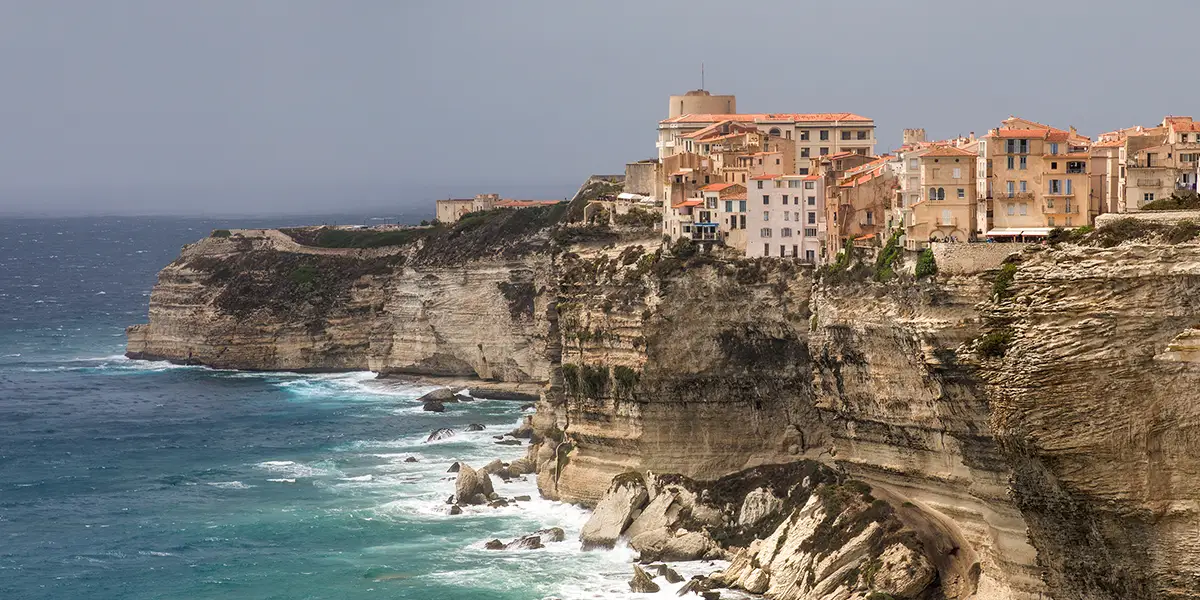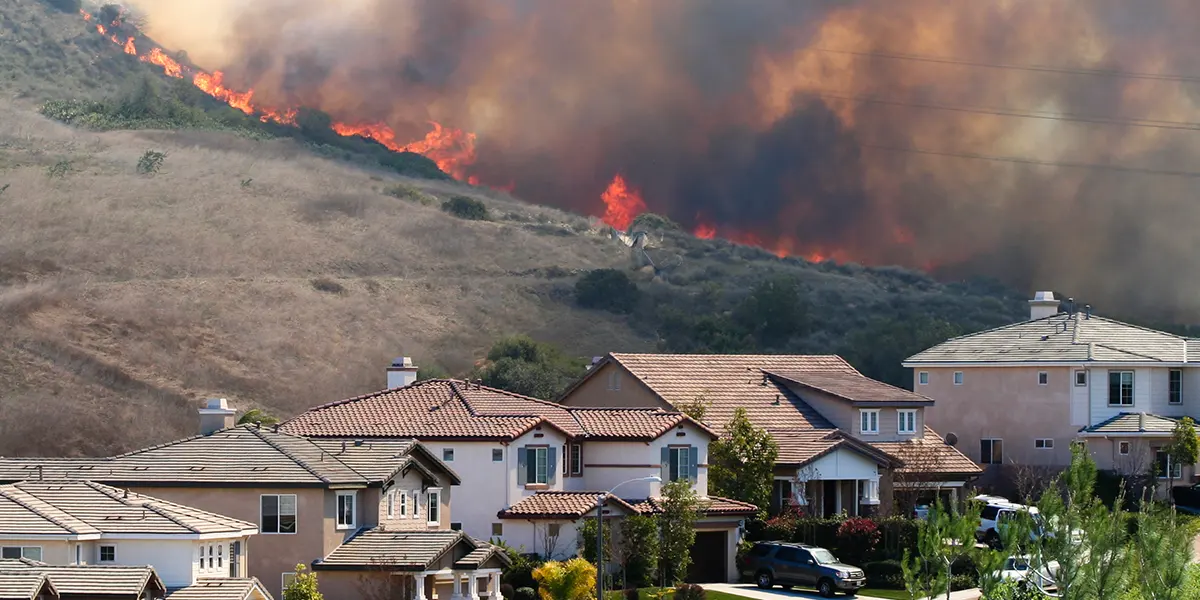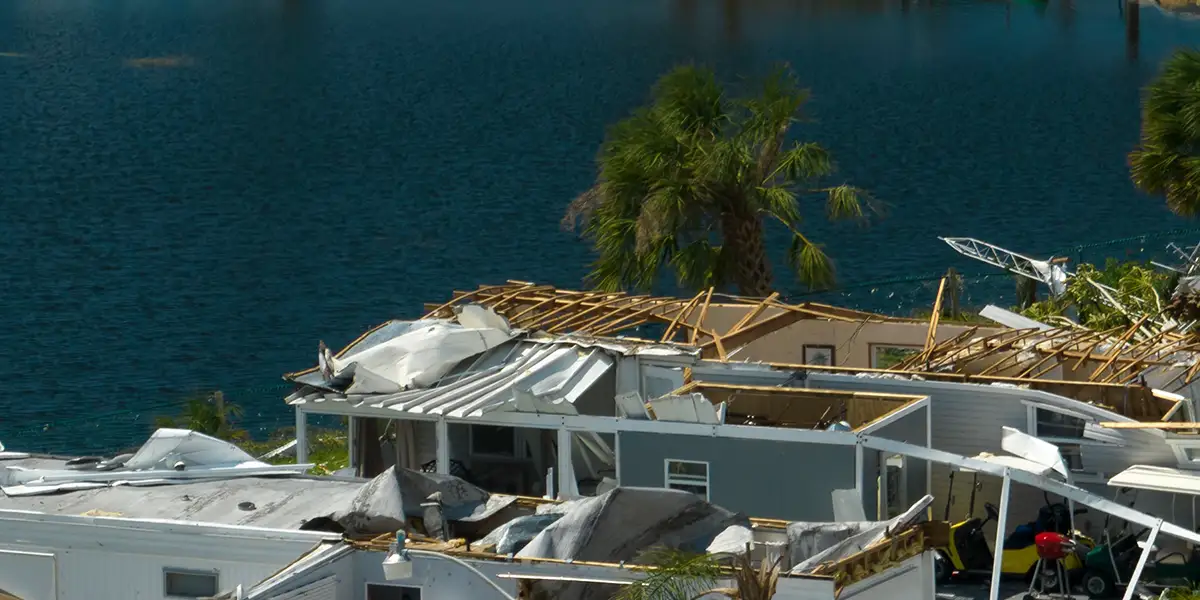Spain is on the frontlines of Europe's drought crisis, facing unprecedented and prolonged dry spells. As one of the top fruit and vegetable producers in the European Union, Spain has experienced a significant rainfall deficit of 28% since October 1st, 2022, compared to the expected levels by mid-May 2023. This severe lack of rain has triggered widespread drought conditions, exerting immense pressure on the nation's water management system. Reservoirs have dried up, fields of crops have withered, and stringent water restrictions have been imposed across the country.
Over the years, Spain's average water availability has steadily decreased by 12% since 1980, and projections indicate that it could decline to 14-40% by 2050. The combination of drought and heat has raised concerns of a recurrence of last summer's devastating events, including scorching heatwaves and rampant wildfires that ravaged approximately 306,000 hectares (756,000 acres).
Recognising the situation's urgency, the Spanish government has approved a €2.2 billion plan to mitigate the impacts of the drought. However, these harmful conditions are expected to worsen in Spain and across the rest of Europe.
Scorching Spain
The prolonged droughts in Spain are placing immense strain on various industries nationwide. The severity of these droughts is evident in figure 1 below, which highlights the areas experiencing drought emergencies in red. These regions include the Ebro basin, the interior of Catalonia, the Bay of Biscay, the east and south of Andalusia, Murcia, and the southeast of Castilla-La Mancha. Alarmingly, this collectively accounts for approximately 34.8% of the entire Spanish territory currently enduring prolonged drought conditions. The extent of these droughts reinforces the predictions made by AEMET, which indicates a 50% to 70% likelihood of this summer being one of the five hottest periods in the past three decades. Such elevated temperatures exacerbate the challenges posed by the ongoing drought crisis.
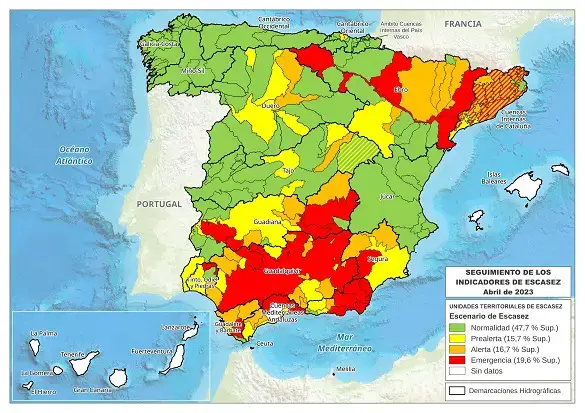
Industry leaders are increasingly concerned as Spain experiences unusual heatwaves, depleted reservoir levels since December 2022, and a widespread lack of rainfall affecting 80% of the country’s countryside. While occasional heavy rains during these dry periods provide temporary relief, the inability to effectively capture and store rainwater exacerbates the water scarcity. In May, rainfall primarily occurred along the coast rather than inland. Unfortunately, the lack of adequate infrastructure prevents the capture and storage of rainwater for later use.
Some cities, such as Alicante, Barcelona or Valencia, have begun devising proposals against flooding with river reservoirs and floodplain parks to store water in heavy rains to overcome these drawbacks. Spain’s environment minister, Teresa Ribera, has said ”we [the Spanish government] need to deal with episodes such as the present one – and that requires planning, structural measures and also, obviously, short-term and immediate help plans.” Such prevention also comes in the form of technology. In Spain, there are currently 765 desalination plants with production of more than 100 m³/day that produce around 5,000,000 cubic meters of desalinated water are produced in Spain per day to support the water scarcity not only for industries but also for drinking water.
For Spain this year, there is light at the end of the tunnel as it is forecasted to be rainy in October 2023. It does not end the drought or fill the reservoirs, but will the rain somewhat alleviates droughts. In the long term, extreme weather events are set for the future, with intense droughts met by torrential rains. All that remains is to adapt to the severe droughts to cement the future.
On the Brink: Catalonia
In particular, the situation in the northeastern region of Catalonia is currently critical and catastrophic. The average water levels in Catalonia’s reservoirs are at a concerning 27%, leading to the implementation of strict water restrictions throughout the region. Since March 2023, the impact of the water crisis has been felt by nearly 6 million Catalans across 224 municipalities, exacerbating the severity of the water drought. To combat the worsening conditions, authorities have introduced laws to address the water shortage. These measures include a 40% reduction in water allocation for agricultural purposes, a 15% reduction for industrial uses, and a decrease in the average daily water supply per resident from 250 to 230 litres.
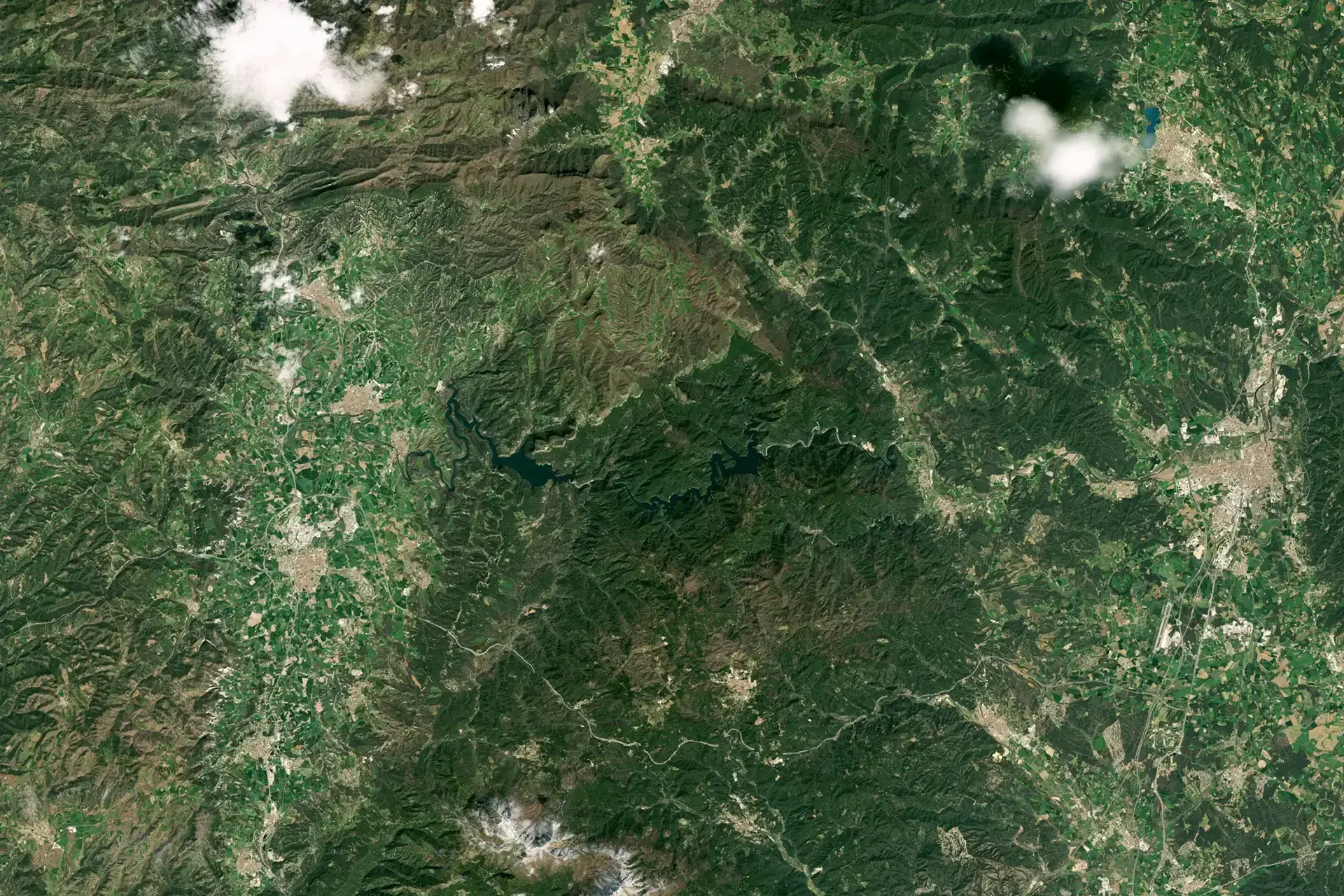
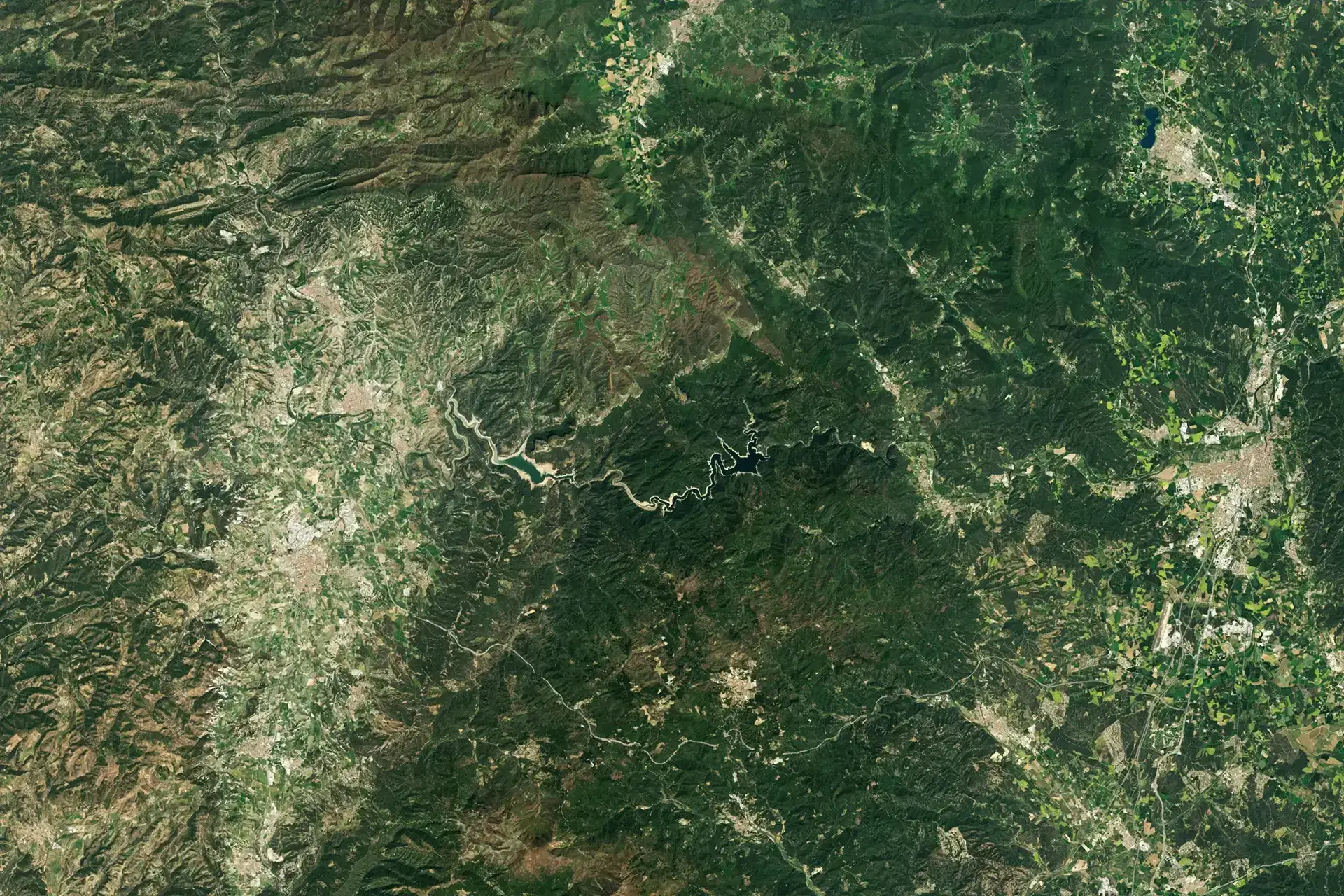
“This is an extraordinary measure […] adopted to preserve the water quality… and be able to guarantee the population’s demands as much as possible,” stated the Catalan government. However, it is essential to recognise that the challenges posed by the drought extend beyond Catalonia and affect the entire nation of Spain.
Drying Up
With the increasing drought, wildfires are becoming a growing concern. Extremadura in southwest Spain has already destroyed at least 12,000 hectares (29,600 acres) of land, as depicted in figure 3 below. Rubén del Campo, a spokesperson for Aemet, emphasised the impending danger of wildfires in the upcoming summer, stating "the risk of fires could be very high given the high temperatures.” Between January 1st to April 30th, 2023, 3,530 wildfires have been registered in Spain, surpassing the decade average by more than double. Nannete Wong, Director of Marine & Aviation at Aon Risk Solutions highlights the heightening climate risk of wildfires in Spain “as wildfires become more frequent and intense, they threaten individual well-being as well as the interconnected operations of the business world”. Ultimately, wildfires across Spain have and will put enormous pressure on insurance and real estate companies, affecting mortgage rates in areas prone to wildfires and heightened claims on real estate assets lost by forcing industries to assume more than initially bargained for.
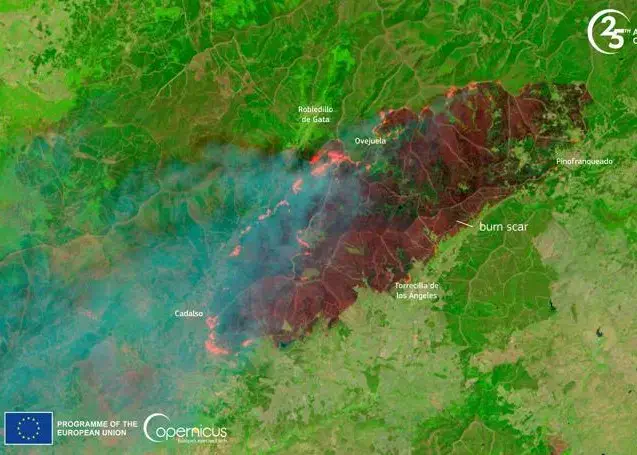
The drought in Spain has had a significant impact on the agricultural sector, affecting approximately 60% of the country's countryside and leading to the destruction of crops across 3.5 million hectares (8.6 million acres), equivalent to the size of Bulgaria. Spain, the world's third-largest exporter of tomatoes with an annual value of $1 billion, also produces wheat, barley, rice, and olive oil. The repercussions of these agricultural damages have placed a heavy burden on the insurance industry. This year's drought is forecasted to be the most significant claim in the history of agriculture insurance, with an estimated €300 million claim to be paid by Agroseguro, Spain's leading agricultural insurance provider. In comparison, last year's compensation for damages caused by drought amounted to €117 million affecting a total area of nearly 1.3 million hectares. These figures demonstrate the significant escalation of damage caused by the current severe drought.
Across Borders
Beyond Spain, droughts are expected to worsen across Europe. Recent data reveals that more than a quarter of the EU's 27-nation bloc is currently experiencing warning conditions for droughts, as indicated in figure 4 below, with 8% of the region under drought alert. Unusually, severe drought conditions were witnessed in Europe and several other regions during the winter of 2022-2023; Europe's temperature has risen almost twice as fast as the global average over the past three decades, leading to various consequences such as reduced freight passage due to low river levels, decreased hydroelectricity output, increased electricity prices, and crop failures caused by drought.
The severity of the situation is underscored by the fact that soil moisture across Europe in 2022 was the second lowest in the past 50 years. Italy, for example, is grappling with a significant decrease in the water levels of the Po River, which irrigates approximately one-third of the country's agricultural production. Compared to April 2022, the river's water volume has plummeted by 61%. Mainland Portugal is also heavily affected, with roughly 90% of its territory experiencing drought, including 20% facing a severe drought. Moreover, not only Spain, Italy, and Portugal face vulnerability; other regions like "Poland and other regions like Bulgaria, Romania, and Greece are showing warning conditions for drought," said Andrea Toreti, a senior researcher at the European Commission's Joint Research Center.
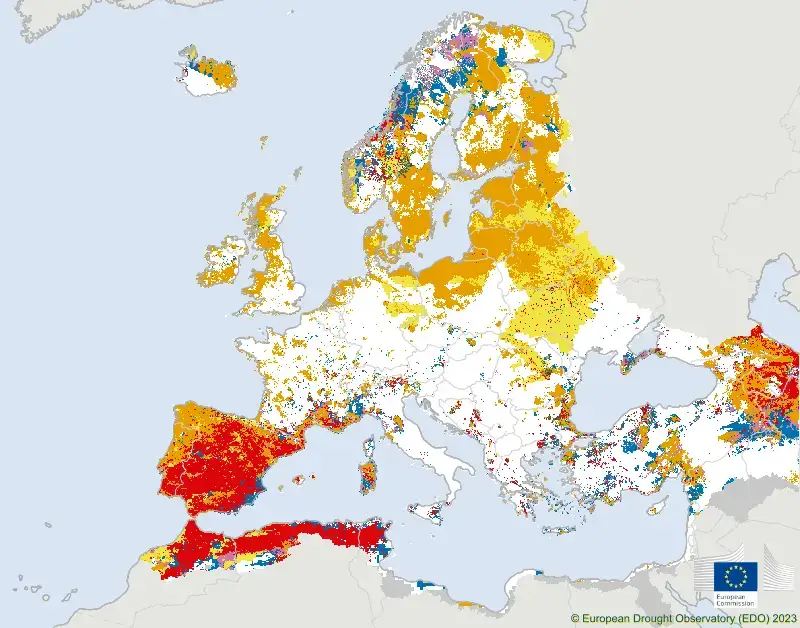
The pressing question is how Spain and other vulnerable European nations' deal will effectively address the mounting challenge of escalating droughts. Beyond implementing water use restrictions, organisations must proactively prepare for droughts and the broader range of climate-related risks stemming from these droughts. Chloe Brimicombe, a climate researcher at the University of Graz in Austria, believes water scarcity was a particularly acute problem in southern Europe, “but I do think that central and Western Europe are less prepared — and in the coming years it has the potential to hit them in a way that they really aren’t expecting”.
For a significant portion of Europe, the anticipated consequences of climate change have become a stark reality. Climate X can provide accurate and comprehensive granular data with our Spectra analytical platform to empower organisations with the necessary information to make difficult yet crucial decisions in anticipation of increasingly severe droughts.
Drought - 2050, Spain
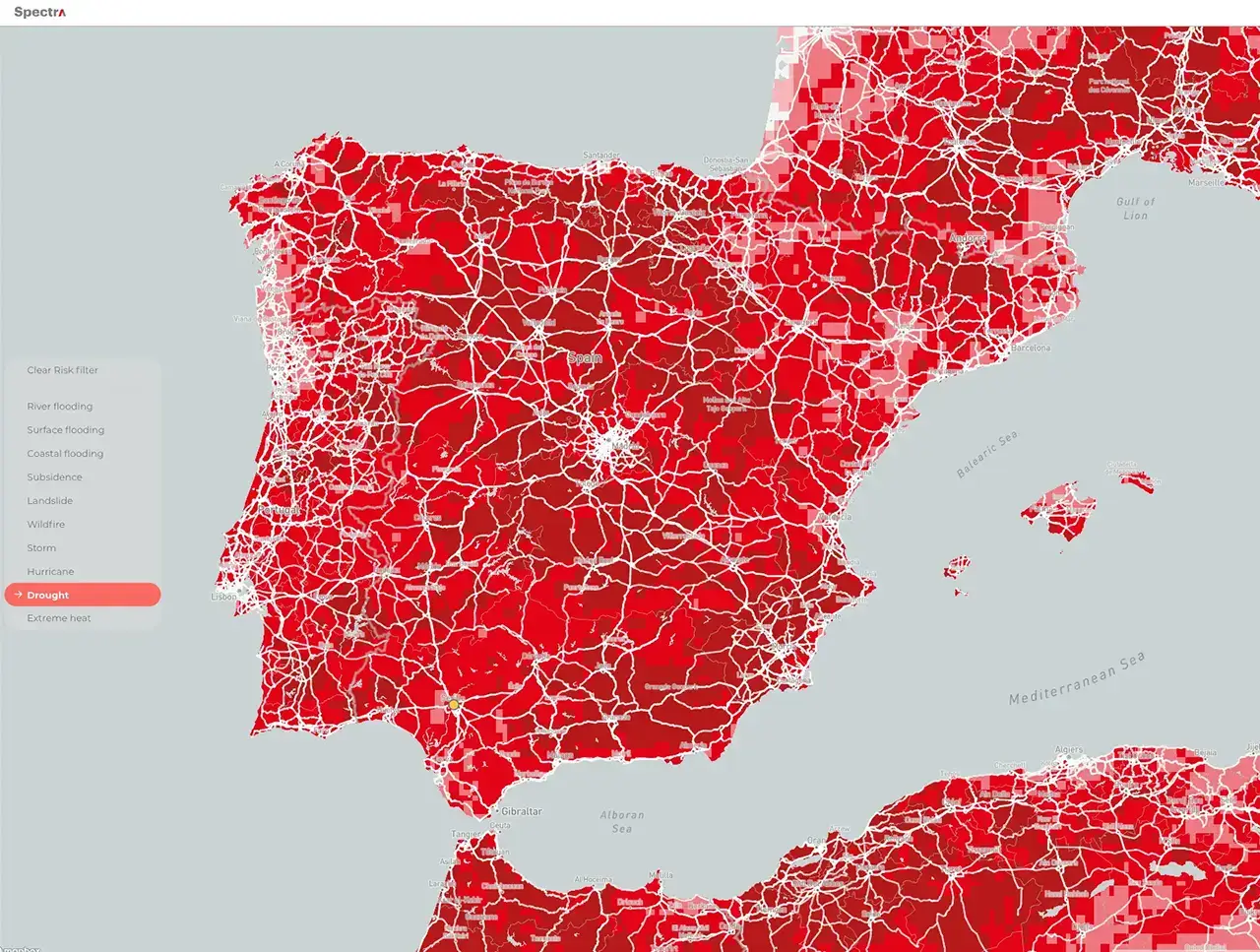
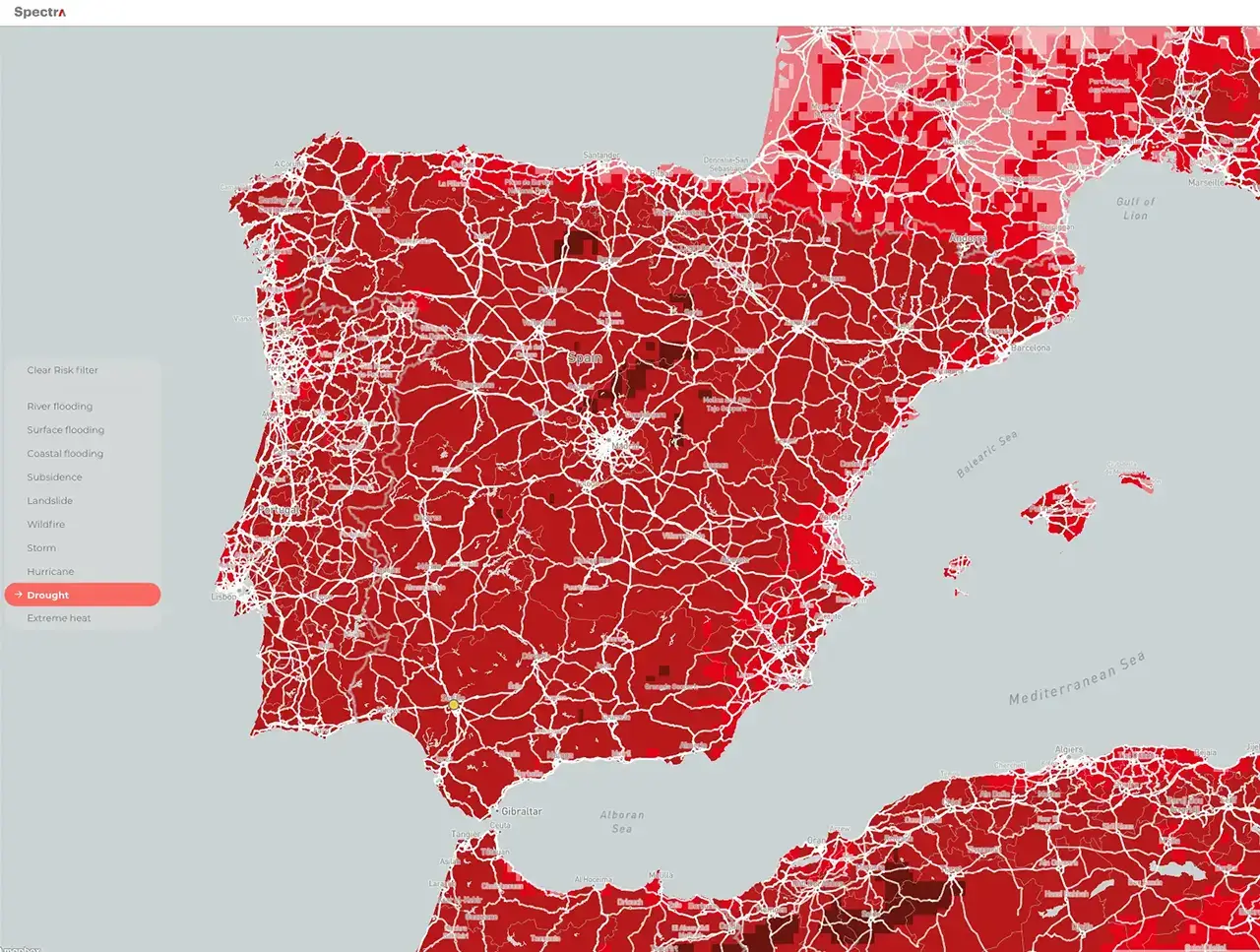
Extreme Heat - 2050, Spain
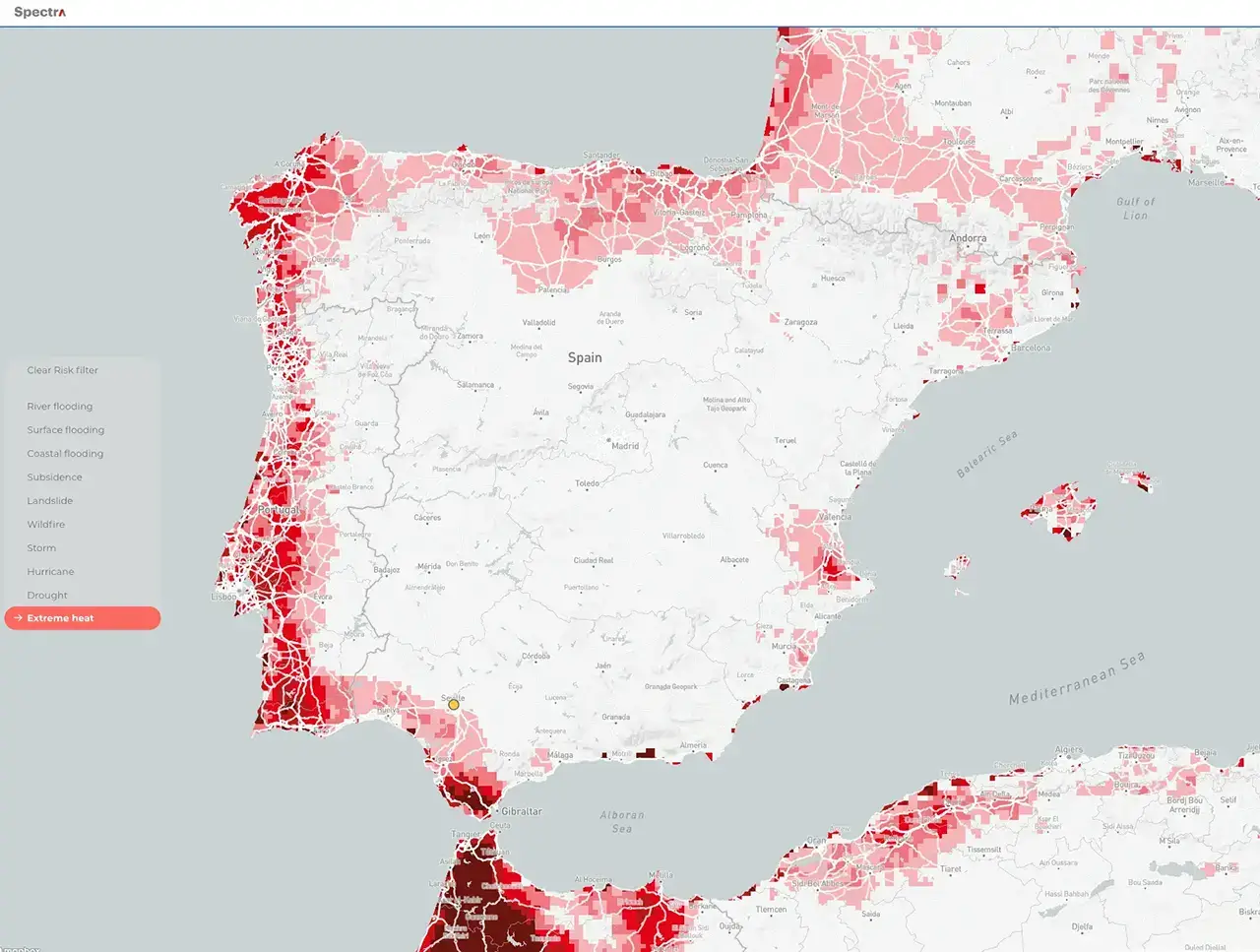
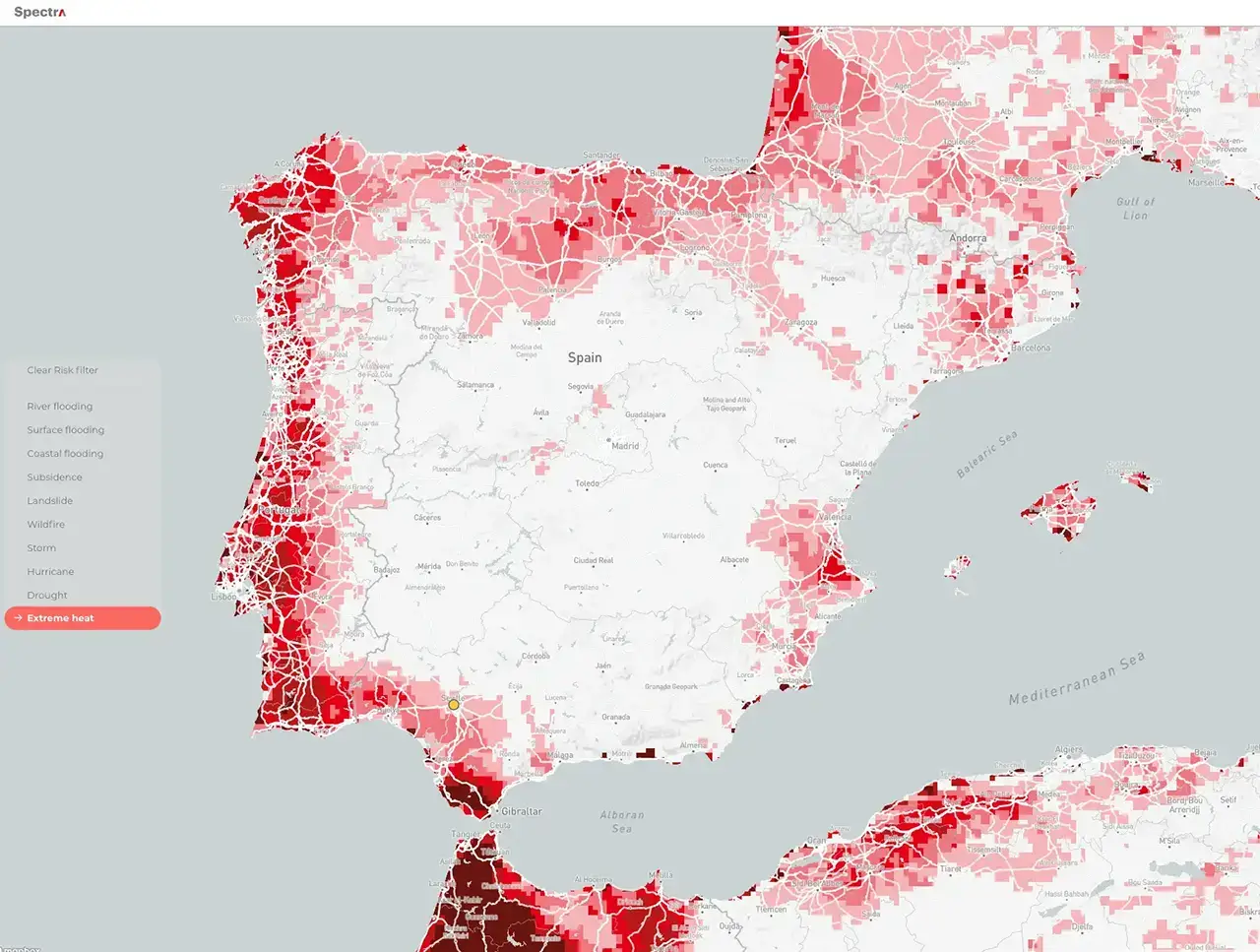
Sources
- AgroInsurance (2023) Spain - Long-term drought to bring more heatwaves, widlfires. https://agroinsurance.com/en/News/Spain---Long-term-drough
- Allianz (2023) Water in 2023 – is history repeating or just rhyming? https://www.allianzgi.com/en-gb/insights/outlook-and-commentary/water-in-2023
- Ajuntament de Barcelona (2023) How can I visit the rainwater and wastewater regulation tanks? https://ajuntament.barcelona.cat/lafabricadelsol/es/content/como-puedo-visitar-los-depositos-de-regulacion-de-aguas-pluviales-y-residuales
- Aon (2022) Forest fires: more frequent, more serious and more expensive. https://noa.aon.es/riesgo-incendios-forestales/
- AP News (2023) Drought in Spain’s northeast empties reservoirs. https://apnews.com/article/spain-drought-barcelona-reservoirs-956fc841cec86c8fca42686c3c513c54
- Association of Spain’s Desalination (2019) Desalination figures in Spain. https://aedyr.com/cifras-desalacion-espana/#:~:text=Seg%C3%BAn%20los%20datos%20m%C3%A1s%20actualizados,abastecimiento%2C%20riego%20y%20uso%20industrial
- Ayuntamiento de Alicante (2023) La Marjal Park. https://www.alicante.es/es/equipamientos/parque-marjal
- Bloomberg (2023) Spain’s Drought Shows Climate Change Is Here. https://www.bloomberg.com/news/newsletters/2023-05-11/spain-s-drought-shows-climate-change-is-here
- COAG (2023) The drought already suffocates 80% of the Spanish countryside and produces irreversible losses in more than 5 million hectares of rainfed cereals. https://coag-cyl.org/coag-cyl/la-sequia-asfixia-ya-al-80-del-campo-espanol-y-produce-perdidas-irreversibles-en-mas-5-millones-de-hectareas-de-cereales-de-secano/
- Copernicus (2023) Edo - European Drought Observatory. https://edo.jrc.ec.europa.eu/edov2/php/index.php?id=1000
- Copernicus (2023) European State of the Climate 2022 Unprecedented extreme heat and widespread drought mark European climate in 2022. https://climate.copernicus.eu/copernicus-european-state-climate-2022-unprecedented-extreme-heat-and-widespread-drought-mark
- CNBC (2023) Europe is struggling with a precarious water situation ahead of another drought-riven summer. https://www.cnbc.com/2023/06/05/expected-european-drought-likely-to-worsen-the-regions-water-crisis-.html
- CNN (2023) This once-thriving lake has all but dried up. It’s a story repeated across Europe as the drought deepens. https://edition.cnn.com/2023/03/30/europe/europe-drought-lake-montbel-france-climate-intl/index.html
- Earth Observatory (2023) Spain Browned by Drought. https://earthobservatory.nasa.gov/images/151366/spain-browned-by-drought#:~:text=Since%20the%20start%20of%20the,water%20restrictions%20across%20the%20country.
- Efe: Agro (2023) Forest fires double in Spain compared to the average of the last decade. https://efeagro.com/incendios-forestales-espana-3/
- Efe: Agro (2023) The current drought is the biggest claim in agricultural insurance, with 300 million in damages. https://efeagro.com/la-sequia-actual-supone-el-mayor-siniestro-del-seguro-agrario-con-300-millones-en-danos/
- Generalitat de Catalunya (2023) Catalan Water Agency. https://aplicacions.aca.gencat.cat/visseq/estat-actual
- Generalitat de Catalunya (2023) Climate Action starts the device to preserve the water quality of the Ter river basin for five million people. https://govern.cat/salapremsa/notes-premsa/490542/accio-climatica-engega-dispositiu-preservar-qualitat-laigua-conca-del-riu-ter-cinc-milions-persones
- The Guardian (2023) Unprecedented €2.2bn drought response plan approved in Spain. https://www.theguardian.com/world/2023/may/11/spain-approves-unprecedented-drought-recovery-plan
- Gro Intelligence (2023) EU Fruit & Vegetable Production. https://app.gro-intelligence.com/displays/EqZv7VLq3
- InSpain News (2023) Fire in Extremadura stabilised after destroying nearly 12,000 hectares. https://inspain.news/fire-in-extremadura-stabilised-after-destroying-nearly-12000-hectares/
- La Moncloa (2023) The Government of Spain approves the Third Cycle Hydrological Plans to modernise the management of water resources until 2027. https://www.lamoncloa.gob.es/lang/en/gobierno/councilministers/Paginas/2023/20230124_council.aspx
- Levante (2022) This is the floodplain parks that inspired Valencia. https://www.levante-emv.com/valencia/2022/03/29/son-parques-inundables-inspiran-valencia-64408112.html
- The Ministry for the Ecological Transition and the Demographic Challenge (2023) Monitoring reports and maps. https://www.miteco.gob.es/en/agua/temas/observatorio-nacional-de-la-sequia/informes-mapas-seguimiento/
- Newtral (2022) Desalination plants make their way as an alternative to the drought and already produce 9% of drinking water in Spain. https://www.newtral.es/desaladoras-sequia-2022/20220813/
- OECD Cogito (2023) When the Spring Runs Dry. https://oecdcogito.blog/2023/05/19/when-the-spring-runs-dry/
- Reuters (2023) Spain saw hottest, second-driest spring on record this year. https://www.reuters.com/business/environment/spain-saw-hottest-second-driest-spring-record-this-year-2023-06-07
- Statista (2023) Land burned by forest fires in Spain 2009-2022. https://www.statista.com/statistics/1265354/area-burned-by-wildfire-in-spain/
- World Population Review (2023) Arable Land by Country 2023. https://worldpopulationreview.com/country-rankings/arable-land-by-country

